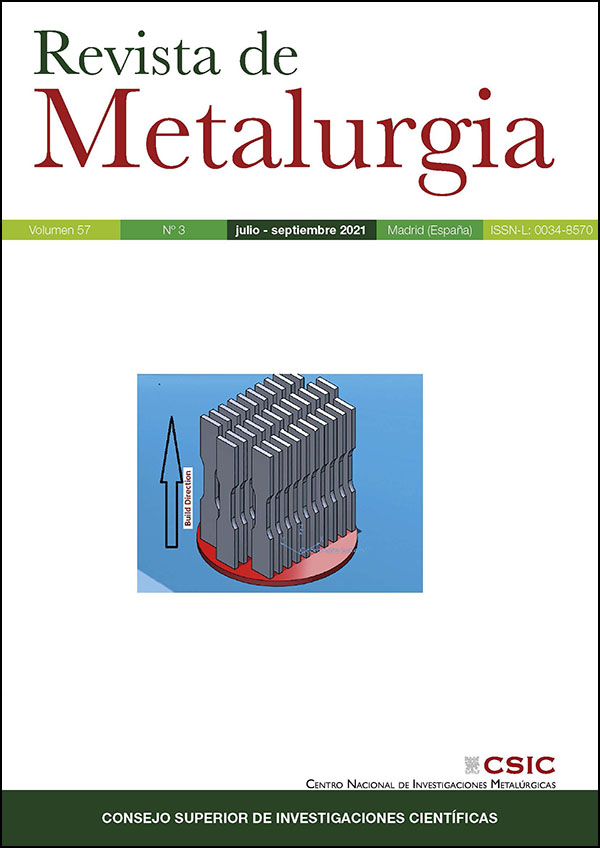The removal of toxic metals from liquid effluents by ion exchange resins. Part XVI: Iron(III)/H+/Lewatit TP208
DOI:
https://doi.org/10.3989/revmetalm.203Keywords:
Lewatit TP208, Liquid effluents, Iron(III), Multiwalled carbon nanotubes, RemovalAbstract
Lewatit TP208 cationic exchange resin was used to remove iron(III) from aqueous solutions under different experimental variables: stirring speed applied to the system, aqueous pH and resin dosage, temperature and metal concentration in the aqueous solution. Maximum metal uptake was achieved around 900 min-1, and the exchange process was dependent both on the variation of the aqueous pH value and the resin dosage. The increase of the temperature was accompanied by an increase of iron(III) uptake onto the resin, thus, demonstrating the endothermic nature of the ion exchange process. Also the percentage of iron(III) removed from the solution strongly depended on the initial iron(III) concentration in the aqueous feed solution. Iron(III) uptake onto the resin was investigated in the presence of other metal ions: Cu(II), Zn(II), Cr(III) and In(III) in the feed solution, and it was also compared with that of Fe(II). This comparison was extended to that about the performance of this resin against that of multiwalled carbon nanotubes with respect to Fe(III) uptake. This metal ion loaded onto the resin can be eluted using acidic solutions.
Downloads
References
Al-Ghamdi, Y.O., Alamry, K.A., Hussein, M.A., Marwani, H.M., Asiri, A.M. (2019). Sulfone-modified chitosan as selective adsorbent for the extraction of toxic Hg(II) metal ions. Adsorpt. Sci. Technol. 37 (1-2), 139-159. https://doi.org/10.1177/0263617418818957
Alguacil, F.J., Coedo, A.G., Dorado, T., Padilla, I. (2002). The removal of toxic metals from liquid effluents by ion exchange resins. Part I: chromium(VI)/sulphate/Dowex 1x8. Rev. Metal. 38, 306-311. https://doi.org/10.3989/revmetalm.2002.v38.i4.412
Alguacil, F.J. (2002). The removal of toxic metals from liquid effluents by ion exchange resins. Part II: cadmium(II)/sulphate/Lewatit TP260. Rev. Metal. 38 (5), 348-352. https://doi.org/10.3989/revmetalm.2002.v38.i5.418
Alguacil, F.J. (2003). The removal of toxic metals from liquid effluents by ion exchange resins. Part III: copper(II)/sulphate/Amberlite 200. Rev. Metal. 39 (3), 205-209. https://doi.org/10.3989/revmetalm.2003.v39.i3.330
Alguacil, F.J., Lopez, F.A., Rodriguez, O., Martinez-Ramirez, S., Garcia-Diaz, I. (2016). Sorption of indium (III) onto carbon nanotubes. Ecotox. Environ. Safety 130, 81-86. https://doi.org/10.1016/j.ecoenv.2016.04.008 PMid:27085001
Alguacil, F.J. (2017a). The removal of toxic metals from liquid effluents by ion exchange resins. Part IV: chromium(III)/H+/Lewatit SP112. Rev. Metal. 53 (2), e093.
Alguacil, F.J. (2017b). The removal of toxic metals from liquid effluents by ion exchange resins. Part V: nickel(II)/H+/Dowex C400. Rev. Metal. 53 (4), e105.
Alguacil, F.J., Garcia-Diaz, I., Lopez, F., Rodriguez, O. (2017). Removal of Cr(VI) and Au(III) from aqueous streams by the use of carbon nanoadsorption technology. Desal. Water Treat. 63, 351-356. https://doi.org/10.5004/dwt.2017.0264
Alguacil, F.J. (2018a). The removal of toxic metals from liquid effluents by ion exchange resins. Part VI: manganese(II)/H+/Lewatit K2621. Rev. Metal. 54 (2), e116.
Alguacil, F.J. (2018b). The removal of toxic metals from liquid effluents by ion exchange resins. Part VII: manganese(VII)/H+/Amberlite 958. Rev. Metal. 54 (3), e125.
Alguacil, F.J., Escudero, E. (2018). The removal of toxic metals from liquid effluents by ion exchange resins. Part VIII: arsenic(III)/OH/Dowex 1x8. Rev. Metal. 54 (4), e132.
Alguacil, F.J. (2019a). The removal of toxic metals from liquid effluents by ion exchange resins. Part IX: lead(II)/H+/Amberlite IR120. Rev. Metal. 55 (1), e138.
Alguacil, F.J. (2019b). The removal of toxic metals from liquid effluents by ion exchange resins. Part X: antimony(III)/H+/Ionac SR7. Rev. Metal. 55 (3), e152.
Alguacil, F.J. (2019c). The removal of toxic metals from liquid effluents by ion exchange resins. Part XI: cobalt(II)/H+/Lewatit TP260. Rev. Metal. 55 (4), e154.
Alguacil, F.J., Escudero, E. (2020). The removal of toxic metals from liquid effluents by ion exchange resins. Part XII: mercury(II)/H+/Lewatit SP112. Rev. Metal. 56 (1), e160.
Alguacil, F.J. (2020a). The removal of toxic metals from liquid effluents by ion exchange resins. Part XIII: zinc(II)/H+/ Lewatit OC-1026 Rev. Metal. 56 (3), e172.
Alguacil, F.J. (2020b). The removal of toxic metals from liquid effluents by ion exchange resins. Part XIV: indium(III)/H+/Dowex-400. Rev. Metal. 56 (4), e184.
Alguacil, F.J. (2021). The removal of toxic metals from liquid effluents by ion exchange resins. Part XV: iron(II)/H+/Lewatit TP208. Rev. Metal. 57 (1), e190. https://doi.org/10.3989/revmetalm.190
Arzate, S., Campos-Mañas, M.C., Miralles-Cuevas, S., Agüera, A., García Sánchez, J.L., Sánchez Pérez, J.A. (2020). Removal of contaminants of emerging concern by continuous flow solar photo-Fenton process at neutral pH in open reactors. J. Environ. Managem. 261, 110265. https://doi.org/10.1016/j.jenvman.2020.110265 PMid:32148322
Bakalár, T., Kaňuchová, M., Girová, A., Pavolová, H., Hromada, R., Hajduová, Z. (2020). Characterization of Fe(III) adsorption onto zeolite and bentonite. Int. J. Environ. Res. Public Health 17 (16), 5718. https://doi.org/10.3390/ijerph17165718 PMid:32784702 PMCid:PMC7460527
Caravaca, C., Cobo, A., Alguacil, F.J. (1994). Considerations about the recycling of EAF flue dusts as source for the recovery of valuable metals by hydrometallurgical processes. Resour. Conserv. Recycl. 10 (1-2), 35-41. https://doi.org/10.1016/0921-3449(94)90036-1
Dauletbay, A. Serikbayev, B.A., Kamysbayev, D.K., Kudreeva, L.K. (2020). Interaction of metal ions with humic acids of brown coals of Kazakhstan. J. Exp. Nanosci. 15 (1), 406-416. https://doi.org/10.1080/17458080.2020.1810240
El-Hamid, A.M.A., Zahran, M.A., Ahmed, Y.M.Z., El-Sheikh, S.M. (2020). Separation of heavy metal ions from petroleum ash liquor using organic resins and FT-IR study of the process. Radiochemistry 62, 243-250. https://doi.org/10.1134/S1066362220020125
Flieger, J., Kawka, J., Płaziński, W., Panek, R., Madej, J. (2020). Sorption of heavy metal ions of chromium, manganese, selenium, nickel, cobalt, iron from aqueous acidic solutions in batch and dynamic conditions on natural and synthetic aluminosilicate sorbents. Materials 13 (22), 5271. https://doi.org/10.3390/ma13225271 PMid:33233399 PMCid:PMC7700620
Geissler, C., Singh, M. (2011). Iron, meat and health. Nutrients 3 (3), 283-316. https://doi.org/10.3390/nu3030283 PMid:22254098 PMCid:PMC3257743
Hamad, A.A., Hassouna, M.S., Shalaby, T.I., Elkady, M.F., Abd Elkawi, M.A., Hamad, H.A. (2020). Electrospun cellulose acetate nanofiber incorporated with hydroxyapatite for removal of heavy metals. Int. J. Biol. Macromol. 151, 1299-1313. https://doi.org/10.1016/j.ijbiomac.2019.10.176 PMid:31751727
Hamza, M.F., Wei, Y., Benettayeb, A., Wang, X.P., Guibal, E. (2019). Efficient removal of uranium, cadmium and mercury from aqueous solutions using grafted hydrazide-micro-magnetite chitosan derivative. J. Mater. Sci. 55, 4193-4212. https://doi.org/10.1007/s10853-019-04235-8
López Díaz-Pavon, A., Cerpa, A., Alguacil, F.J. (2014). Processing of indium(III) solutions via ion exchange with Lewatit K-2621 resin. Rev. Metal. 50 (2), e010. https://doi.org/10.3989/revmetalm.010
Mohaghehian, A., Pourmosheni, M., Vahidi-Kolur, R., Yang, J.-K., Shirzad-Siboni, M. (2017). Preparation and characterization of kaolin coated with Fe3O4 nanoparticles for the removal of hexavalent chromium: kinetic, equilibrium and thermodynamic studies. Desal. Water Treat. 90, 262-272. https://doi.org/10.5004/dwt.2017.21426
Nagla, R.E., Arab, T.T., Greenwood, M.T. (2017). Iron mediated toxicity and programmed cell death: A review and a re-examination of existing paradigms. Biochim. Biophys. Acta-Molecular Cell Res. 1864 (2), 399-430. https://doi.org/10.1016/j.bbamcr.2016.12.002 PMid:27939167
Recalcati, S., Minotti, G., Cairo, G. (2010). Iron regulatory proteins: from molecular mechanisms to drug development. Antiox. Redox Sign. 13 (10), 1593-1616. https://doi.org/10.1089/ars.2009.2983 PMid:20214491
USEPA (2004). Iron. U.S. Environmental Protection Agency. EPA/600/1-78/017, Washington, D.C.
USEPA (2020) Secondary drinking water standards: guidance for nuisance chemicals. U.S. Environmental Protection Agency. Accessed June 2021. www.epa.gov. https://www.epa.gov/sdwa/secondary-drinking-water-standards-guidance-nuisance-chemicals.
Wang, L., Wang, Y., Cui, L., Gao, J., Guo, Y., Cheng, F. (2020). A sustainable approach for advanced removal of iron from CFA sulfuric acid leach liquor by solvent extraction with P507. Sep. Purif. Technol. 251, 117371. https://doi.org/10.1016/j.seppur.2020.117371
Zhang, X., Zhou, K., Wu, Y., Lei, Q., Peng, C., Chen, W. (2020). Separation and recovery of iron and scandium from acid leaching solution of red mud using D201 resin. J. Rare Earths 38 (12), 1322-1329. https://doi.org/10.1016/j.jre.2019.12.005
Zhu, K., Ren, X., Li, H., Wei, Q. (2021). Simultaneous extraction of Ti(IV) and Fe(III) in HCl solution containing multiple metals and the mechanism research. Sep. Purif. Technol. 257, 117897 https://doi.org/10.1016/j.seppur.2020.117897
Published
How to Cite
Issue
Section
License
Copyright (c) 2021 Consejo Superior de Investigaciones Científicas (CSIC)

This work is licensed under a Creative Commons Attribution 4.0 International License.
© CSIC. Manuscripts published in both the printed and online versions of this Journal are the property of Consejo Superior de Investigaciones Científicas, and quoting this source is a requirement for any partial or full reproduction.
All contents of this electronic edition, except where otherwise noted, are distributed under a “Creative Commons Attribution 4.0 International” (CC BY 4.0) License. You may read the basic information and the legal text of the license. The indication of the CC BY 4.0 License must be expressly stated in this way when necessary.
Self-archiving in repositories, personal webpages or similar, of any version other than the published by the Editor, is not allowed.
















